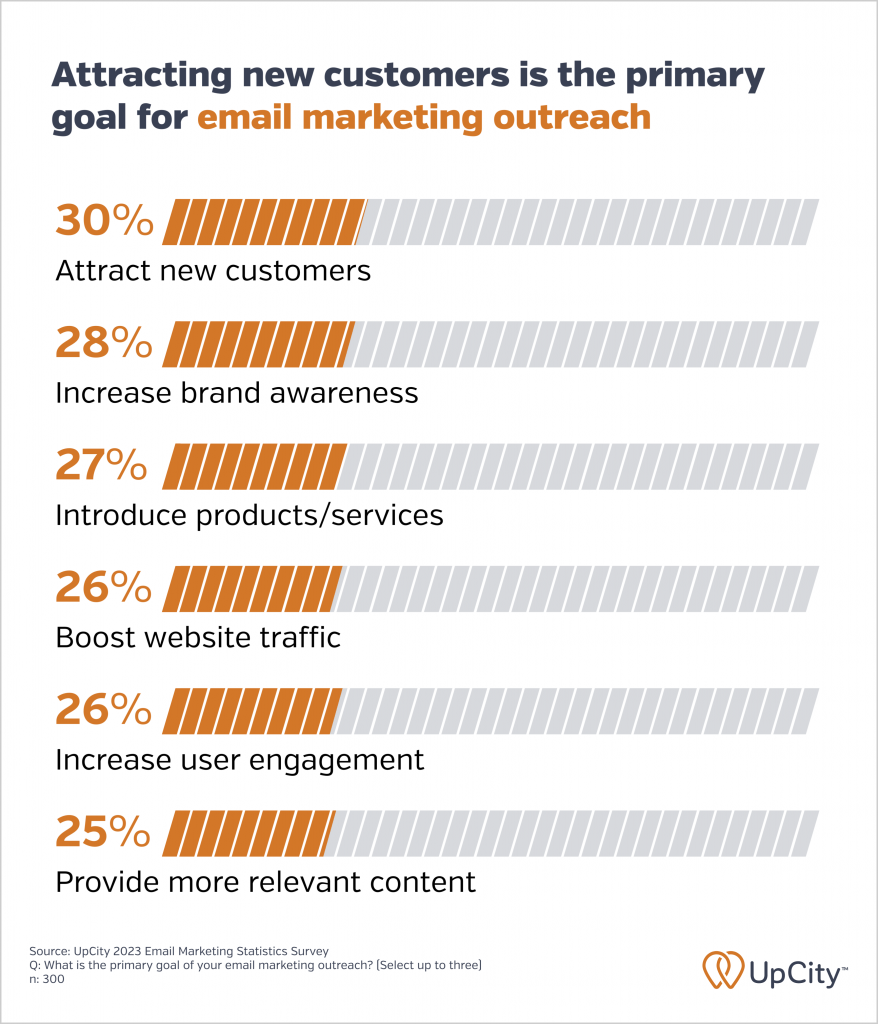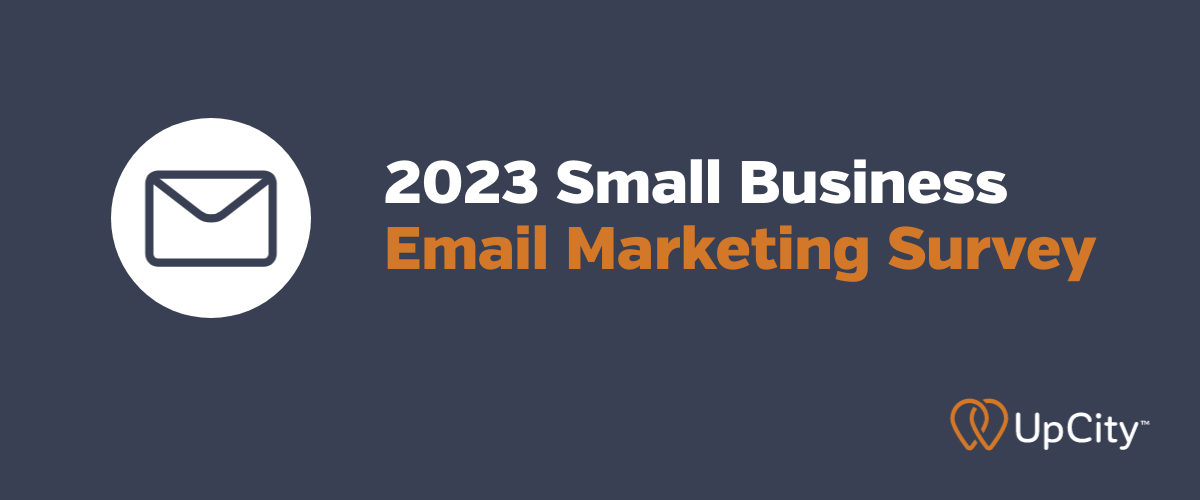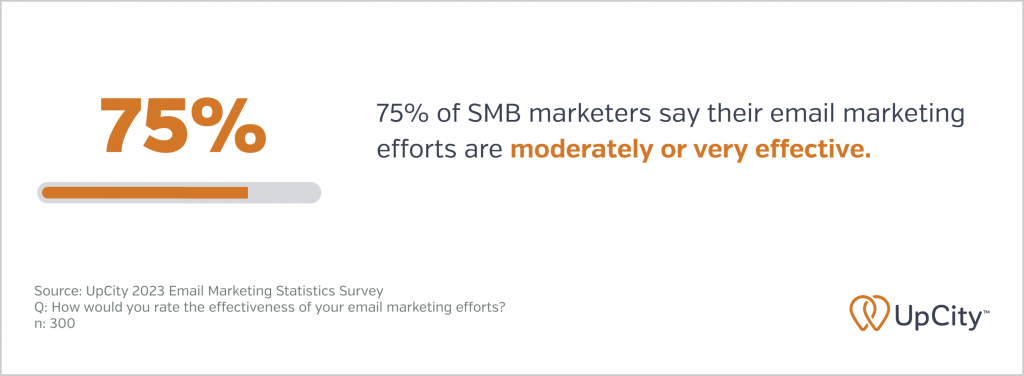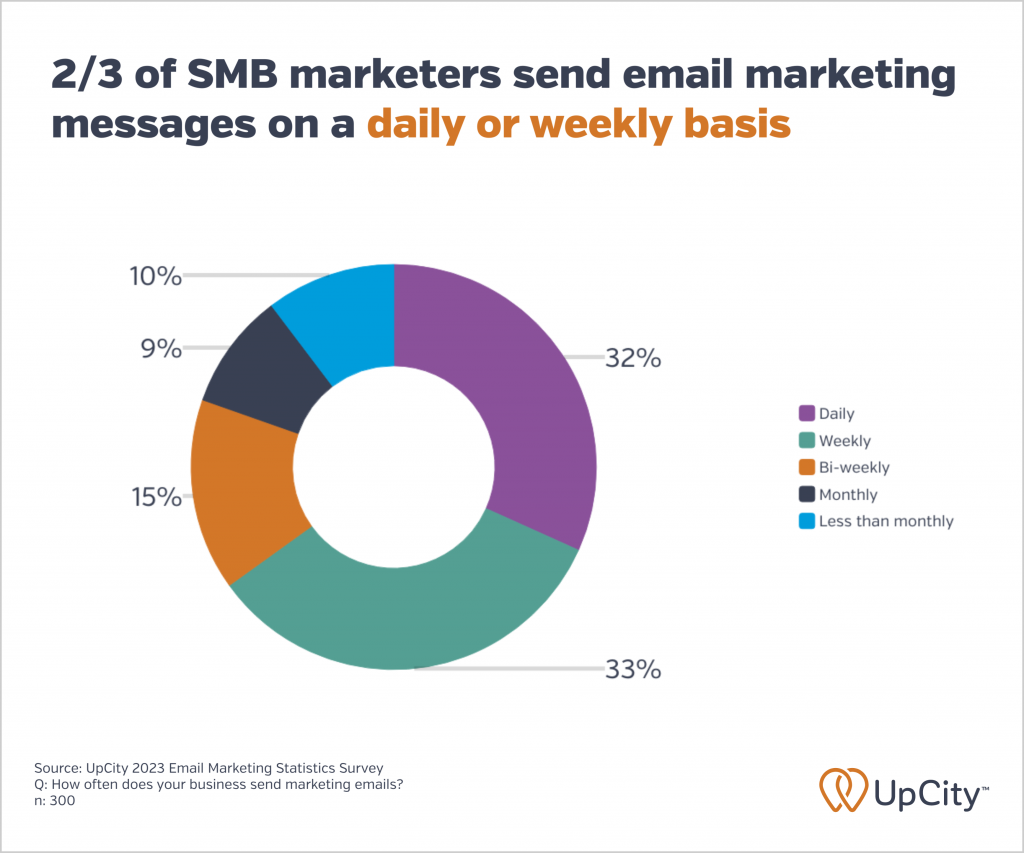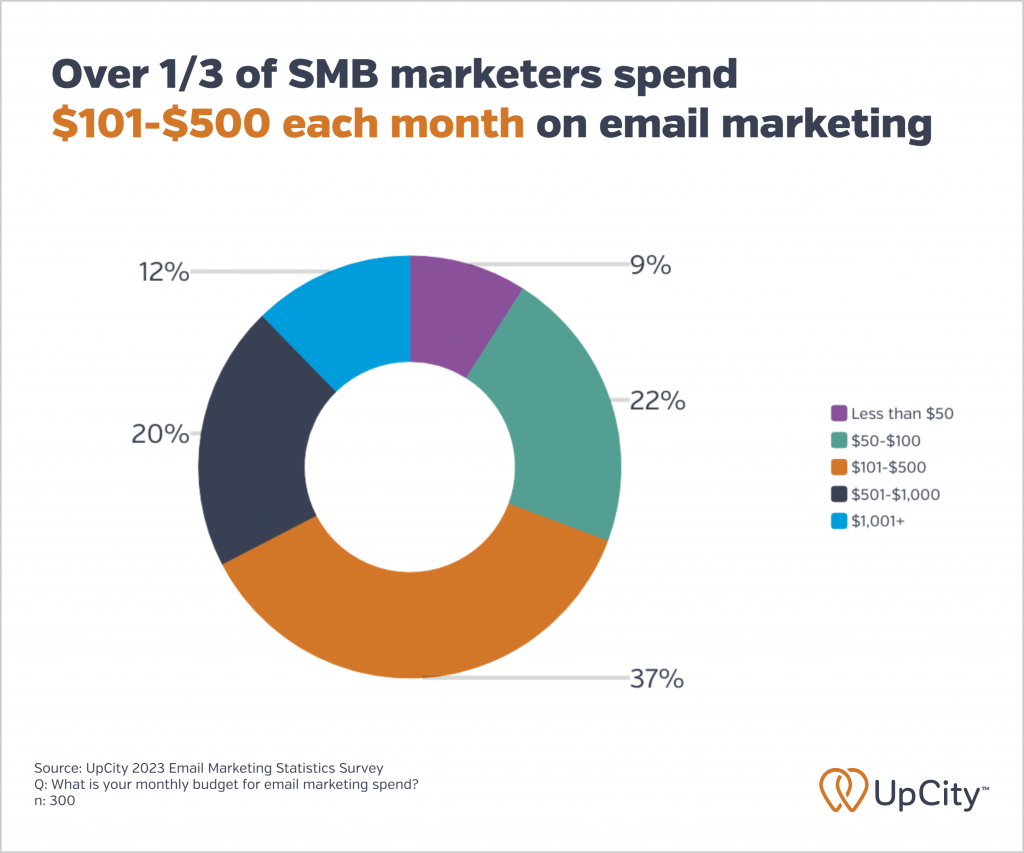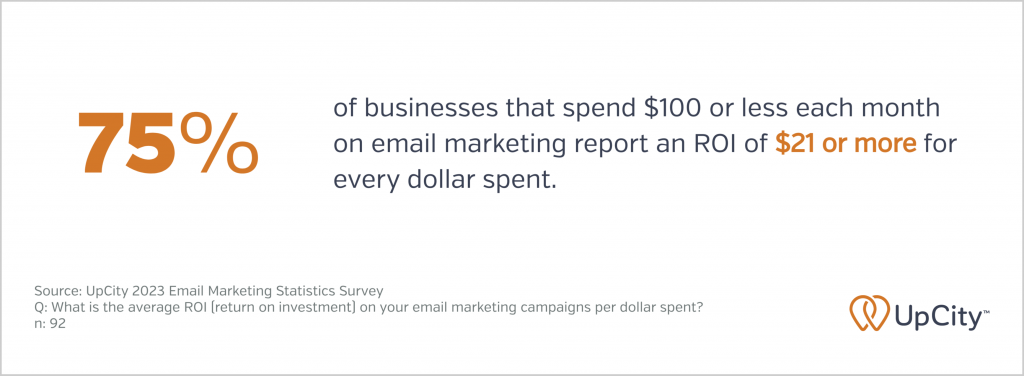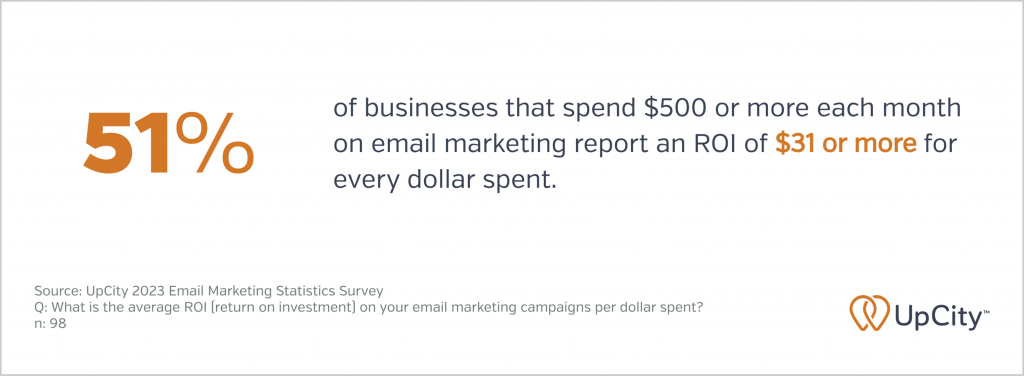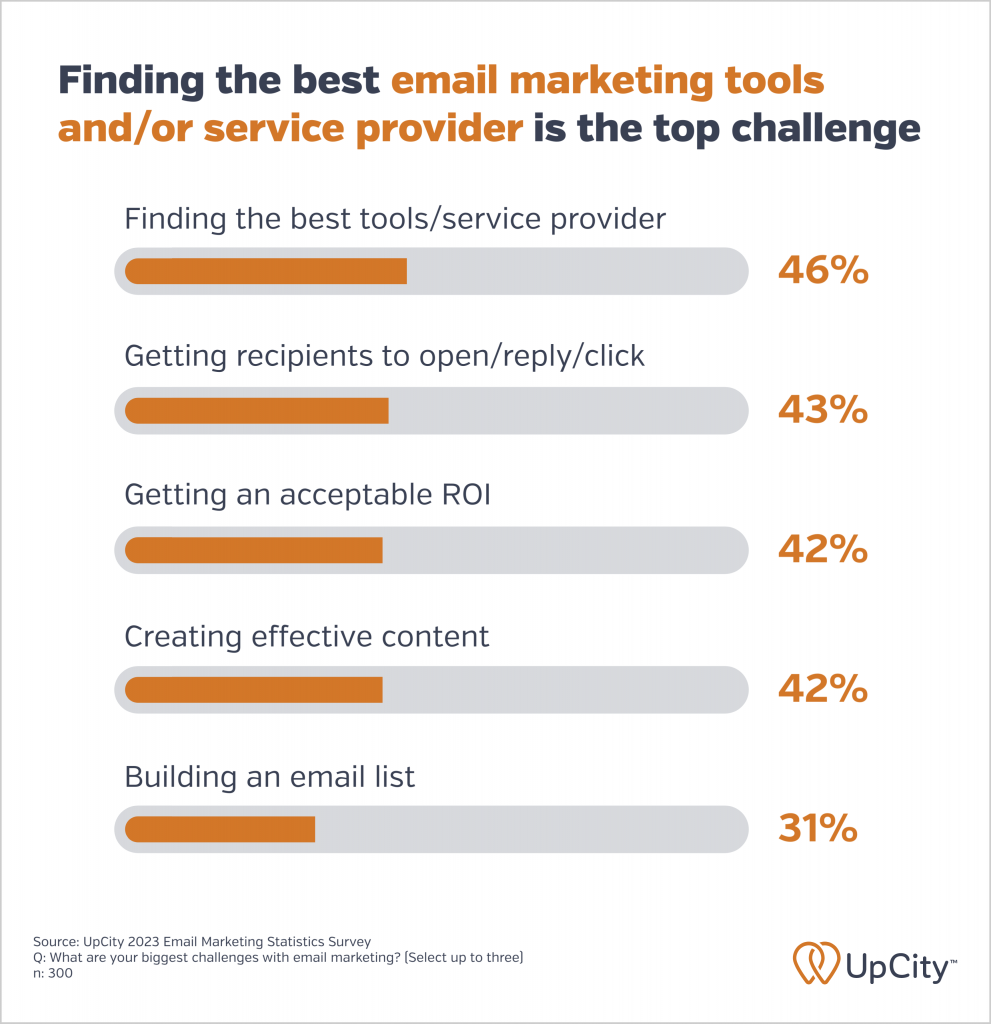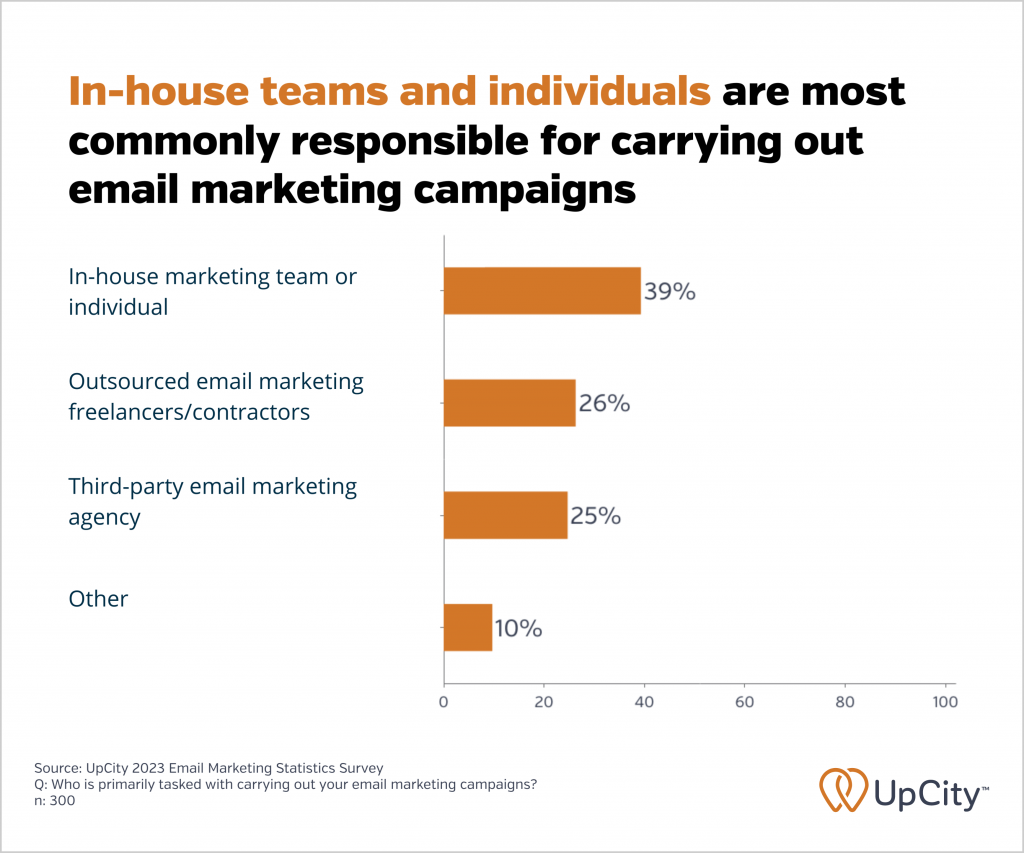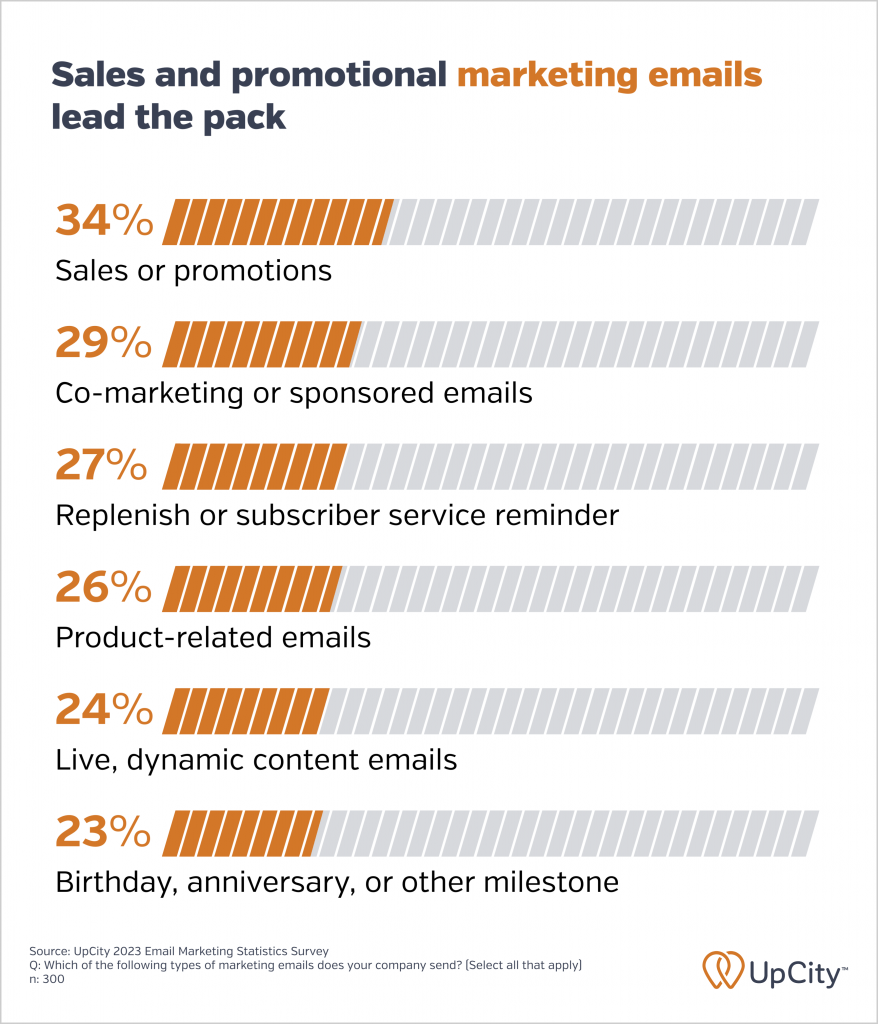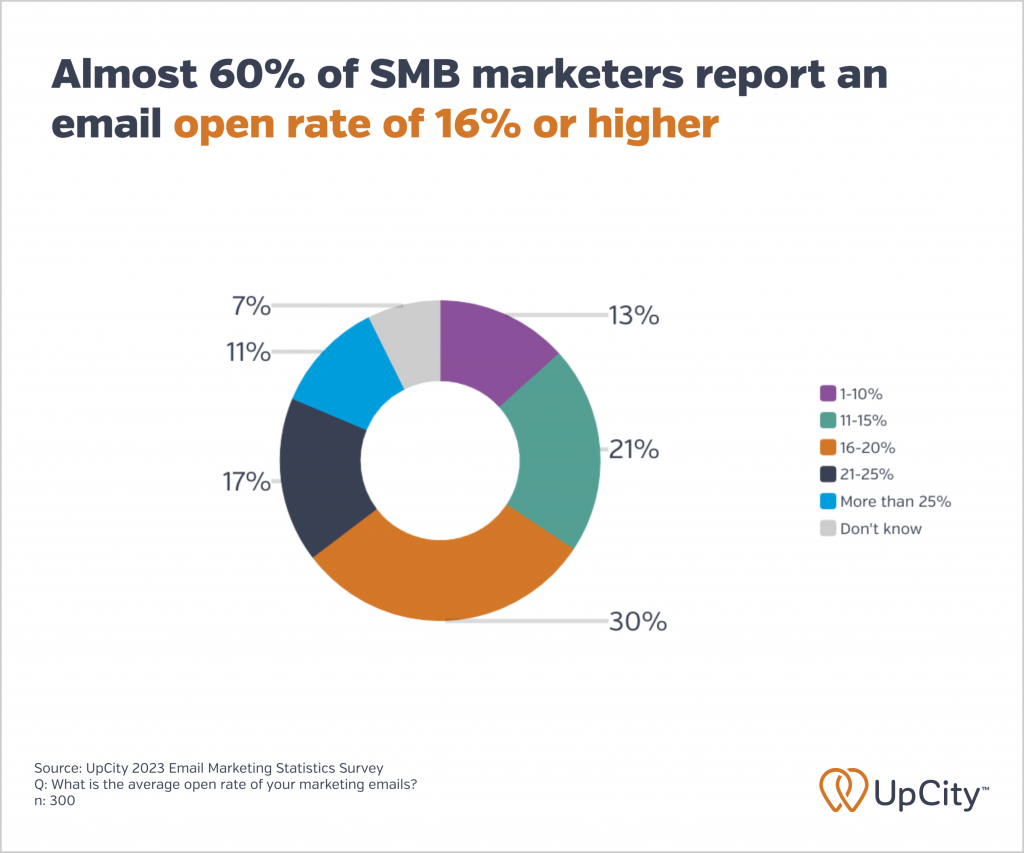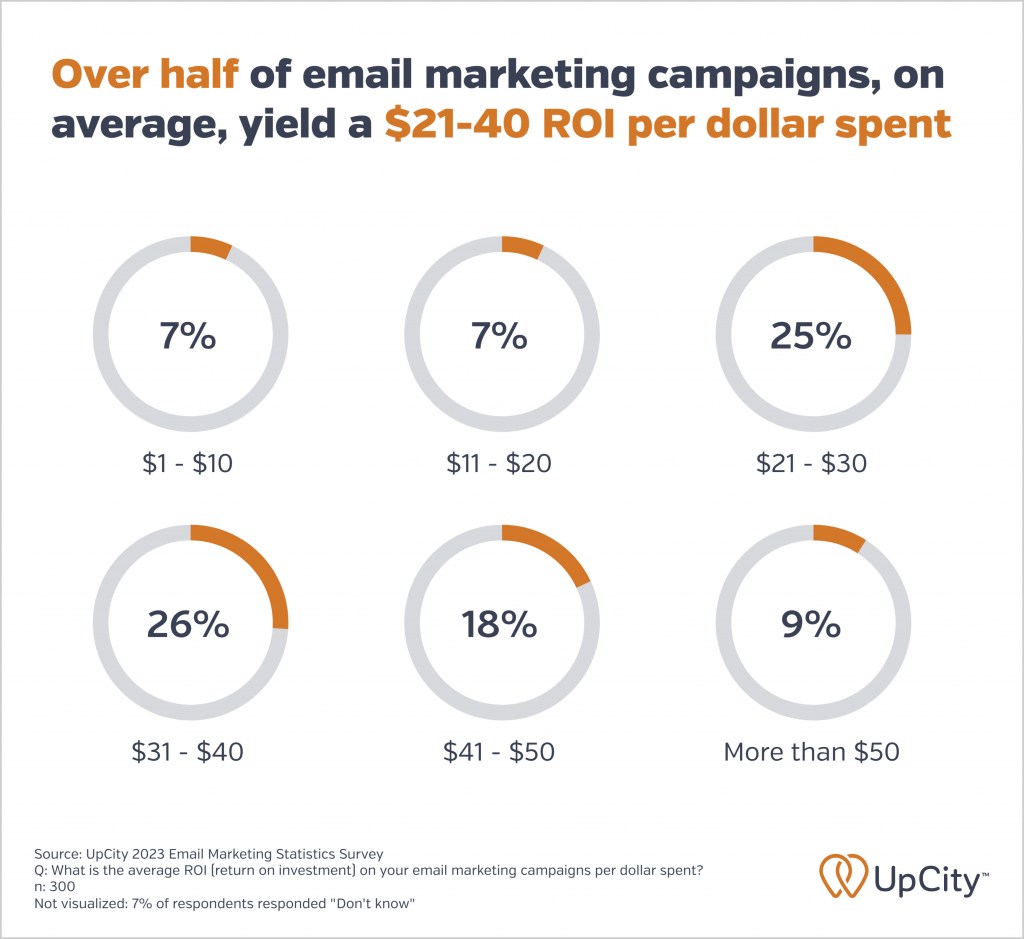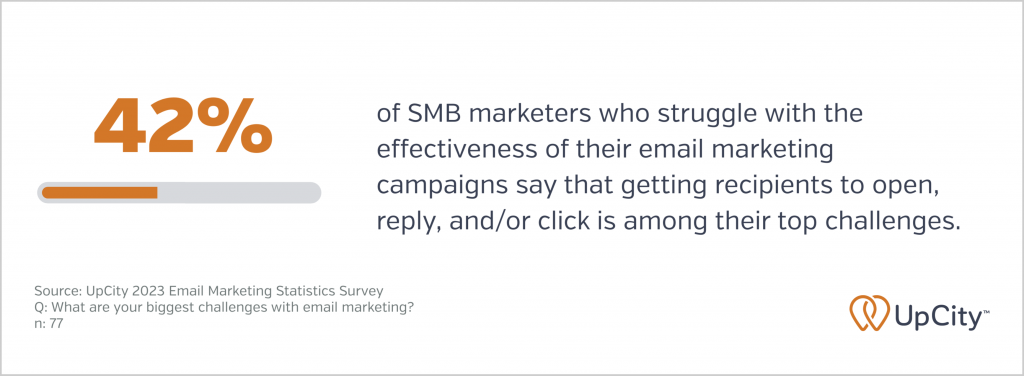The economic landscape is very different for marketers to navigate in 2023 than it was even a year ago, as instability looms over industries and the threat of a recession has business owners remaining cautious on some marketing fronts, but more aggressive in other channels.
One channel that consistently delivers results, no matter the economic season, is email marketing. In fact, our recent survey of 300 marketing professionals found that almost 75% considered their email marketing efforts to be effective.
In this update of our 2022 email marketing survey, we gathered data from 300 marketing professionals who regularly leverage email for their marketing strategies on:
- Email marketing cadences
- Campaigns and goals
- Email marketing budgets
- Email marketing task management
- And overall email marketing effectiveness
Let’s dive in.
Email marketing cadence: Frequency and consistency are key
Like many marketing strategies, the effectiveness of email as a marketing tool can vary depending on how you time the distribution of emails to your client lists.
65% of the SMB marketers we surveyed send their marketing emails on either a daily (32%) or weekly (33%) basis
Email marketing taps into one of the most precious consumer commodities marketing can target: consumer attention. And it does so via a channel that consumers actively protect. (Just think of how quick you are to click that unsubscribe button when a particularly annoying email hits your inbox.)
This is why it’s so important for your inbound marketing infrastructure to instill trust in potential leads and clients. When a client or potential client shares their contact information with you, they’re trusting you to protect that information and only use it to send relevant and valuable information to them.
Our data shows that the majority of our panel of marketing experts are divided almost evenly between sending out weekly communications and sending out daily emails in order to maximize lead generation and boost brand awareness.
Of course the ideal cadence will vary greatly depending on your business and how engaged your email subscribers are, and we generally would recommend erring on the side of less frequent emails rather than overwhelming and alienating your subscribers with daily communication before your audience is ready for it.
Weekly emails allow your team to reach more of your audience over time and give them a reliable and easy-to-integrate cadence without feeling bombarded by your marketing and sales apparatus. Keep track of your email marketing analytics or consult your marketing services provider to determine the best email marketing frequency for your business.
Time of day impacts the effectiveness of email campaigns: earlier is generally better
Cadence means more than just how often marketers are sending out emails, but also at what times throughout the day. For example, data gathered by HubSpot shows that marketers in certain industries generally have more success sending emails out early in the week rather than at the end of the week, and then even more impact is gained if those emails are sent between 9 am and 12 noon [1].
The idea is that later in the day and later in the week, your potential audience is more likely to be thinking about something other than reading marketing emails, like what they’re going to do over the weekend or what they’re going to have for dinner. But what about shift workers, or what if your business sends marketing emails for restaurants?
Again, there’s no magic, universal answer to these questions, and the best course of action is to pay attention to your results and work with marketing professionals (internal or external) to come up with best practices for your specific business needs.
Campaigns and goals: Adding customers is key
Your marketing department should have guidelines for marketing automation in place, such as templates and standard response times. However, they should also prioritize the creation of a well-segmented and managed customer list for sales and marketing communication.
This managed list, which should be optimized over time to ensure a low bounce rate and unsubscribe rate, allows marketing and sales initiatives to be built around the right customer. These campaigns can serve a number of purposes, depending on your current marketing initiatives.
Attracting new customers was the primary goal for almost one-third of our respondents (30%), while inspiring recipients to take action lagged behind (23%)
In our survey, we asked marketing experts to share what they hoped to accomplish most through their email marketing campaigns. Their goals were split fairly evenly, with roughly 25% of those surveyed reporting that their focus was either on customer retention, user engagement, increasing brand awareness, or introducing new products and services.
Attracting new customers led the pack of priorities at 30%, which is an understandable focus for many business owners, given the state of the economy. Businesses seem to be very focused on increasing active customers by growing their email subscriber lists so that they have a wider potential client base. More clients now should help shore up revenue streams against the potential of an economic recession and downturn in business.
While statistically still an important factor, it’s interesting that inspiring email recipients to take action, at 23%, is the least of marketers’ concerns based on our survey. This indicates a shift in messaging and the overall goal of email campaigns towards educating and informing rather than purely driving conversions.
Traditionally, emails would be a perfect method for driving customer traffic towards landing pages, eCommerce platforms, and intake forms, with the hope of increasing revenue. Instead, brands seem to be relying on the power of inspiring and engaging with recipients, then gradually introducing solutions and services to help solve the problems the recipient is facing without the hard sales approach.
Email marketing budgets: Bigger investment, bigger return
The pandemic caused businesses everywhere to completely reassess and restructure their marketing budgets around the tactics that were most effectively bringing revenue to the bottom line.
Business owners quickly realized that consumers were also looking for an experience during their downtime, and content marketing and email marketing emerged as champions of the downturn for driving and maintaining customer engagement.
The largest segment of our respondents (37%) spend between $101 and $500 each month on email marketing
The biggest segment of our respondents continue to invest between $101-$500 in marketing spend each month on email marketing campaigns in 2023, much as they were doing post-COVID in 2022.
Based on the spread in this year’s update, larger businesses are still spending more on email marketing, while smaller businesses are investing on a smaller scale, and might be struggling to see the value.
Notably, more than half (52%) of the businesses that reported spending $100 or less each month on email marketing still reported strong open rates of 16% or higher, and almost 75% of those budget-minded businesses reported an ROI of $21 or more for every dollar spent.
On the other end of the spectrum, big-spending businesses ($500+ per month) enjoyed moderately higher open rates–with 57% reporting open rates of 16% or higher–and more than half (51%) of those businesses yielding an ROI of $31 or more for every dollar spent on email marketing.
In other words, whatever your business is able to budget for email marketing–whether it’s $50 per month or $500 per month–is likely to be a wise investment, and the determining factor might just be how much growth your business is prepared to handle.
As we’ll discuss more in detail below, even the most basic email campaign when executed properly can have a massive return on investment, justifying almost any upfront expenditures.
Email marketing is the answer, the question is how you go about it
It’s no secret that running a business is becoming increasingly technical and complex. We’ve become more and more reliant on software solutions for automating repetitive, time-consuming tasks. While it takes significant upfront planning and strategizing, email marketing campaigns are fertile ground for automation, and there are countless tools that can be used to streamline your campaigns.
Unfortunately, as anyone who has been tasked with selecting a business solution in a crowded market can attest, a plethora of options can be both a blessing and a curse.
Finding the best tool or service provider to run an email marketing campaign is the biggest challenge (46%) faced by our respondents, who found building an email list to be far less challenging (31%)
As 46% of our respondents point out, finding the right email marketing software and automation tool for your business can be one of the most challenging and overwhelming tasks for a business marketing team.
This could be why a combined majority of 51% of our respondents either outsource email marketing to a third party agency, contractor, or a freelancer. Turning to professionals who are experienced in email strategy can help relieve the burden of identifying such tools.
It’s the 39% of our respondents handling email marketing in house, however, who are largely struggling with finding the right tools to manage these campaigns themselves. Because so many are executing these campaigns with software tools but also having to keep up with other marketing-focused duties, it follows that other challenges topping the list include creating effective content for campaigns (42%) and maximizing click-through rates (43%).
What our respondents aren’t struggling with, however, is actually building out their lists, as social media channels like Facebook and LinkedIn provide perfect platforms to create content designed to build communities of interested potential clients and followers.
Gathering data in the modern era has become almost a given; the new challenge has become figuring out how to best convert that data into profitability once it’s in your database.
Overall, email marketing still shows its effectiveness
As a small business owner or marketing expert, you’ve probably heard for years (and seen in this report) that email marketing is one of the most profitable and effective strategies that your brand can leverage to grow your business. Let’s further explore the impact that email marketing has on revenue generation and profitability.
Sales and promotional emails are the #1 type of marketing email sent by our respondents (34%), while newsletters, blogs, and cart abandonment emails all lagged in popularity (15-16%)
Content marketing and email marketing go hand-in-hand, especially if the goal is to capture the attention of post-pandemic consumers focused on experience and knowledge over being sold to.
However, while marketers are still using email as a channel to deliver newsletters and blog content, the bulk of email coming out of marketing departments looks to be supporting the customer journey, from welcome emails after a sale to invitations to re-engage with the brand.
As the less popular content, such as blogs and email newsletters [2], can be delivered through other channels, marketers report using email more for communicating sales and promotions.
While this is a strong, sales-focused marketing approach that allows for A/B testing and other litmus tests to maximize campaign impact, it’s likely most often being used as the end point in the inbound marketing chain. The purchase decision-making process can be carefully guided with a well-crafted inbound marketing campaign supported by a strong email marketing component.
A closer look at the numbers supports this approach further, as the most popular types of marketing emails used by the subset of marketers who said that their campaigns were “very effective” were product-related, sales and marketing, and sponsored emails.
Notably, sponsored emails also enjoy the best open rates, with 31.5% of our respondents who claimed open rates of 16-25% reporting that they send co-marketing or sponsored emails.
Almost 1/3 of the marketers we surveyed report an average email open rate of between 16% and 20%
Your email campaign will only be as effective as the email subject lines and content they include. Ultimately, these factors will determine whether your audience is enticed enough to open and read your emails. This is why it’s important to build out your email marketing lists and properly segment them according to demographics and interest in your various products and services.
Achieving average open rates of around 16%-20% is an achievable goal for marketing experts using the tools they have available for audience segmentation and message targeting. Maximizing your open rate is critical to ensure your return on investment for any email marketing campaign, as a higher open rate will directly impact your click-through and conversion rates down the line.
More than half of the email marketers we surveyed reported an average ROI of $21-$40 for every dollar spent on their email marketing campaigns
For years now, we’ve been reading about the massive return on investment (ROI) potential of email marketing, making it one of the most profitable tools in a marketing team’s toolbox. In years past, the average hovered around $36 per dollar spent, but in 2023, post-pandemic studies have shown that the ROI of email marketing is closer to $42 per dollar spent [3].
The average ROI should have a fairly wide range, given the variety of tools and services being used by our respondents, not to mention industry variance. Even given the potential range of outcomes, over time it becomes obvious that the benefits of email marketing far outweigh the costs and labor expenses.
Take for example the 7% of respondents who report earning $11-$20 per dollar spent on email marketing. A reliable $15 return on every dollar spent is nothing to sneeze at. And even more valuable than the ROI is the community and brand loyalty that a successful email campaign can instill, helping customers to better bond with your business over time.
Almost 3/4 of the SMB email marketers we surveyed found their efforts to be moderately (39%) or very (35%) effective
The profitability that comes with email marketing makes it a very lucrative and attractive undertaking for any business. Because of the instability in profitability of other modern marketing tactics, such as pay-per-click advertising, and the relative difficulty in measuring content marketing and SEO, it’s important to employ diverse strategies to deliver results.
Not surprisingly, among the quarter of respondents who struggled with the effectiveness of their email marketing efforts, more than 40% said that getting recipients to open, reply, or click through their emails was one of their biggest challenges. This could mean that better email marketing content could result in better engagement, and ultimately, more effective campaigns.
Email marketing delivers results, so what are you waiting for?
With close to 75% of respondents lauding the effectiveness of their email marketing efforts (and with the open rates and ROI to back it up) it follows that email marketing should be a key component for any strategy focused on growth and success in the coming year.
Yet almost half of the businesses we surveyed struggled to find the right tool or agency to run their campaigns.
If your team is having trouble finding the resources you need to effectively run an email marketing campaign, or you feel like you could use a little guidance to boost your campaigns from good to great, our community of top-rated email marketing consultants is ready to help.
Sources
- 8 Email Cadence Best Practices for Better Email Marketing Campaigns, HubSpot
- How to Start an Email Newsletter, ZeroBounce
- Top Email Marketing ROI Statistics You Need to Know in 2023, mailmodo
Survey methodology
UpCity’s 2023 Email Marketing Statistics Survey was conducted in April 2023 among 300 U.S. respondents to learn about email marketing practices at U.S. businesses. Respondents were screened for marketing roles at companies that send marketing emails.
The economic landscape is very different for marketers to navigate in 2023 than it was even a year ago, as instability looms over industries and the threat of a recession has business owners remaining cautious on some marketing fronts, but more aggressive in other channels.
One channel that consistently delivers results, no matter the economic season, is email marketing. In fact, our recent survey of 300 marketing professionals found that almost 75% considered their email marketing efforts to be effective.
In this update of our 2022 email marketing survey, we gathered data from 300 marketing professionals who regularly leverage email for their marketing strategies on:
- Email marketing cadences
- Campaigns and goals
- Email marketing budgets
- Email marketing task management
- And overall email marketing effectiveness
Let’s dive in.
Email marketing cadence: Frequency and consistency are key
Like many marketing strategies, the effectiveness of email as a marketing tool can vary depending on how you time the distribution of emails to your client lists.
65% of the SMB marketers we surveyed send their marketing emails on either a daily (32%) or weekly (33%) basis
Email marketing taps into one of the most precious consumer commodities marketing can target: consumer attention. And it does so via a channel that consumers actively protect. (Just think of how quick you are to click that unsubscribe button when a particularly annoying email hits your inbox.)
This is why it’s so important for your inbound marketing infrastructure to instill trust in potential leads and clients. When a client or potential client shares their contact information with you, they’re trusting you to protect that information and only use it to send relevant and valuable information to them.
Our data shows that the majority of our panel of marketing experts are divided almost evenly between sending out weekly communications and sending out daily emails in order to maximize lead generation and boost brand awareness.
Of course the ideal cadence will vary greatly depending on your business and how engaged your email subscribers are, and we generally would recommend erring on the side of less frequent emails rather than overwhelming and alienating your subscribers with daily communication before your audience is ready for it.
Weekly emails allow your team to reach more of your audience over time and give them a reliable and easy-to-integrate cadence without feeling bombarded by your marketing and sales apparatus. Keep track of your email marketing analytics or consult your marketing services provider to determine the best email marketing frequency for your business.
Time of day impacts the effectiveness of email campaigns: earlier is generally better
Cadence means more than just how often marketers are sending out emails, but also at what times throughout the day. For example, data gathered by HubSpot shows that marketers in certain industries generally have more success sending emails out early in the week rather than at the end of the week, and then even more impact is gained if those emails are sent between 9 am and 12 noon [1].
The idea is that later in the day and later in the week, your potential audience is more likely to be thinking about something other than reading marketing emails, like what they’re going to do over the weekend or what they’re going to have for dinner. But what about shift workers, or what if your business sends marketing emails for restaurants?
Again, there’s no magic, universal answer to these questions, and the best course of action is to pay attention to your results and work with marketing professionals (internal or external) to come up with best practices for your specific business needs.
Campaigns and goals: Adding customers is key
Your marketing department should have guidelines for marketing automation in place, such as templates and standard response times. However, they should also prioritize the creation of a well-segmented and managed customer list for sales and marketing communication.
This managed list, which should be optimized over time to ensure a low bounce rate and unsubscribe rate, allows marketing and sales initiatives to be built around the right customer. These campaigns can serve a number of purposes, depending on your current marketing initiatives.
Attracting new customers was the primary goal for almost one-third of our respondents (30%), while inspiring recipients to take action lagged behind (23%)
In our survey, we asked marketing experts to share what they hoped to accomplish most through their email marketing campaigns. Their goals were split fairly evenly, with roughly 25% of those surveyed reporting that their focus was either on customer retention, user engagement, increasing brand awareness, or introducing new products and services.
Attracting new customers led the pack of priorities at 30%, which is an understandable focus for many business owners, given the state of the economy. Businesses seem to be very focused on increasing active customers by growing their email subscriber lists so that they have a wider potential client base. More clients now should help shore up revenue streams against the potential of an economic recession and downturn in business.
While statistically still an important factor, it’s interesting that inspiring email recipients to take action, at 23%, is the least of marketers’ concerns based on our survey. This indicates a shift in messaging and the overall goal of email campaigns towards educating and informing rather than purely driving conversions.
Traditionally, emails would be a perfect method for driving customer traffic towards landing pages, eCommerce platforms, and intake forms, with the hope of increasing revenue. Instead, brands seem to be relying on the power of inspiring and engaging with recipients, then gradually introducing solutions and services to help solve the problems the recipient is facing without the hard sales approach.
Email marketing budgets: Bigger investment, bigger return
The pandemic caused businesses everywhere to completely reassess and restructure their marketing budgets around the tactics that were most effectively bringing revenue to the bottom line.
Business owners quickly realized that consumers were also looking for an experience during their downtime, and content marketing and email marketing emerged as champions of the downturn for driving and maintaining customer engagement.
The largest segment of our respondents (37%) spend between $101 and $500 each month on email marketing
The biggest segment of our respondents continue to invest between $101-$500 in marketing spend each month on email marketing campaigns in 2023, much as they were doing post-COVID in 2022.
Based on the spread in this year’s update, larger businesses are still spending more on email marketing, while smaller businesses are investing on a smaller scale, and might be struggling to see the value.
Notably, more than half (52%) of the businesses that reported spending $100 or less each month on email marketing still reported strong open rates of 16% or higher, and almost 75% of those budget-minded businesses reported an ROI of $21 or more for every dollar spent.
On the other end of the spectrum, big-spending businesses ($500+ per month) enjoyed moderately higher open rates–with 57% reporting open rates of 16% or higher–and more than half (51%) of those businesses yielding an ROI of $31 or more for every dollar spent on email marketing.
In other words, whatever your business is able to budget for email marketing–whether it’s $50 per month or $500 per month–is likely to be a wise investment, and the determining factor might just be how much growth your business is prepared to handle.
As we’ll discuss more in detail below, even the most basic email campaign when executed properly can have a massive return on investment, justifying almost any upfront expenditures.
Email marketing is the answer, the question is how you go about it
It’s no secret that running a business is becoming increasingly technical and complex. We’ve become more and more reliant on software solutions for automating repetitive, time-consuming tasks. While it takes significant upfront planning and strategizing, email marketing campaigns are fertile ground for automation, and there are countless tools that can be used to streamline your campaigns.
Unfortunately, as anyone who has been tasked with selecting a business solution in a crowded market can attest, a plethora of options can be both a blessing and a curse.
Finding the best tool or service provider to run an email marketing campaign is the biggest challenge (46%) faced by our respondents, who found building an email list to be far less challenging (31%)
As 46% of our respondents point out, finding the right email marketing software and automation tool for your business can be one of the most challenging and overwhelming tasks for a business marketing team.
This could be why a combined majority of 51% of our respondents either outsource email marketing to a third party agency, contractor, or a freelancer. Turning to professionals who are experienced in email strategy can help relieve the burden of identifying such tools.
It’s the 39% of our respondents handling email marketing in house, however, who are largely struggling with finding the right tools to manage these campaigns themselves. Because so many are executing these campaigns with software tools but also having to keep up with other marketing-focused duties, it follows that other challenges topping the list include creating effective content for campaigns (42%) and maximizing click-through rates (43%).
What our respondents aren’t struggling with, however, is actually building out their lists, as social media channels like Facebook and LinkedIn provide perfect platforms to create content designed to build communities of interested potential clients and followers.
Gathering data in the modern era has become almost a given; the new challenge has become figuring out how to best convert that data into profitability once it’s in your database.
Overall, email marketing still shows its effectiveness
As a small business owner or marketing expert, you’ve probably heard for years (and seen in this report) that email marketing is one of the most profitable and effective strategies that your brand can leverage to grow your business. Let’s further explore the impact that email marketing has on revenue generation and profitability.
Sales and promotional emails are the #1 type of marketing email sent by our respondents (34%), while newsletters, blogs, and cart abandonment emails all lagged in popularity (15-16%)
Content marketing and email marketing go hand-in-hand, especially if the goal is to capture the attention of post-pandemic consumers focused on experience and knowledge over being sold to.
However, while marketers are still using email as a channel to deliver newsletters and blog content, the bulk of email coming out of marketing departments looks to be supporting the customer journey, from welcome emails after a sale to invitations to re-engage with the brand.
As the less popular content, such as blogs and email newsletters [2], can be delivered through other channels, marketers report using email more for communicating sales and promotions.
While this is a strong, sales-focused marketing approach that allows for A/B testing and other litmus tests to maximize campaign impact, it’s likely most often being used as the end point in the inbound marketing chain. The purchase decision-making process can be carefully guided with a well-crafted inbound marketing campaign supported by a strong email marketing component.
A closer look at the numbers supports this approach further, as the most popular types of marketing emails used by the subset of marketers who said that their campaigns were “very effective” were product-related, sales and marketing, and sponsored emails.
Notably, sponsored emails also enjoy the best open rates, with 31.5% of our respondents who claimed open rates of 16-25% reporting that they send co-marketing or sponsored emails.
Almost 1/3 of the marketers we surveyed report an average email open rate of between 16% and 20%
Your email campaign will only be as effective as the email subject lines and content they include. Ultimately, these factors will determine whether your audience is enticed enough to open and read your emails. This is why it’s important to build out your email marketing lists and properly segment them according to demographics and interest in your various products and services.
Achieving average open rates of around 16%-20% is an achievable goal for marketing experts using the tools they have available for audience segmentation and message targeting. Maximizing your open rate is critical to ensure your return on investment for any email marketing campaign, as a higher open rate will directly impact your click-through and conversion rates down the line.
More than half of the email marketers we surveyed reported an average ROI of $21-$40 for every dollar spent on their email marketing campaigns
For years now, we’ve been reading about the massive return on investment (ROI) potential of email marketing, making it one of the most profitable tools in a marketing team’s toolbox. In years past, the average hovered around $36 per dollar spent, but in 2023, post-pandemic studies have shown that the ROI of email marketing is closer to $42 per dollar spent [3].
The average ROI should have a fairly wide range, given the variety of tools and services being used by our respondents, not to mention industry variance. Even given the potential range of outcomes, over time it becomes obvious that the benefits of email marketing far outweigh the costs and labor expenses.
Take for example the 7% of respondents who report earning $11-$20 per dollar spent on email marketing. A reliable $15 return on every dollar spent is nothing to sneeze at. And even more valuable than the ROI is the community and brand loyalty that a successful email campaign can instill, helping customers to better bond with your business over time.
Almost 3/4 of the SMB email marketers we surveyed found their efforts to be moderately (39%) or very (35%) effective
The profitability that comes with email marketing makes it a very lucrative and attractive undertaking for any business. Because of the instability in profitability of other modern marketing tactics, such as pay-per-click advertising, and the relative difficulty in measuring content marketing and SEO, it’s important to employ diverse strategies to deliver results.
Not surprisingly, among the quarter of respondents who struggled with the effectiveness of their email marketing efforts, more than 40% said that getting recipients to open, reply, or click through their emails was one of their biggest challenges. This could mean that better email marketing content could result in better engagement, and ultimately, more effective campaigns.
Email marketing delivers results, so what are you waiting for?
With close to 75% of respondents lauding the effectiveness of their email marketing efforts (and with the open rates and ROI to back it up) it follows that email marketing should be a key component for any strategy focused on growth and success in the coming year.
Yet almost half of the businesses we surveyed struggled to find the right tool or agency to run their campaigns.
If your team is having trouble finding the resources you need to effectively run an email marketing campaign, or you feel like you could use a little guidance to boost your campaigns from good to great, our community of top-rated email marketing consultants is ready to help.
Sources
Survey methodology
UpCity’s 2023 Email Marketing Statistics Survey was conducted in April 2023 among 300 U.S. respondents to learn about email marketing practices at U.S. businesses. Respondents were screened for marketing roles at companies that send marketing emails.
